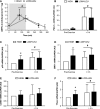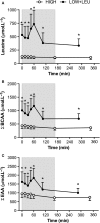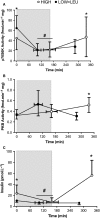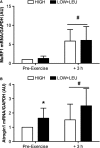Fuel for the work required: a practical approach to amalgamating train-low paradigms for endurance athletes
- PMID: 27225627
- PMCID: PMC4886170
- DOI: 10.14814/phy2.12803
Fuel for the work required: a practical approach to amalgamating train-low paradigms for endurance athletes
Abstract
Using an amalgamation of previously studied "train-low" paradigms, we tested the effects of reduced carbohydrate (CHO) but high leucine availability on cell-signaling responses associated with exercise-induced regulation of mitochondrial biogenesis and muscle protein synthesis (MPS). In a repeated-measures crossover design, 11 males completed an exhaustive cycling protocol with high CHO availability before, during, and after exercise (HIGH) or alternatively, low CHO but high protein (leucine enriched) availability (LOW + LEU). Muscle glycogen was different (P < 0.05) pre-exercise (HIGH: 583 ± 158, LOW + LEU: 271 ± 85 mmol kg(-1) dw) but decreased (P < 0.05) to comparable levels at exhaustion (≈100 mmol kg(-1) dw). Despite differences (P < 0.05) in exercise capacity (HIGH: 158 ± 29, LOW + LEU: 100 ± 17 min), exercise induced (P < 0.05) comparable AMPKα2 (3-4-fold) activity, PGC-1α (13-fold), p53 (2-fold), Tfam (1.5-fold), SIRT1 (1.5-fold), Atrogin 1 (2-fold), and MuRF1 (5-fold) gene expression at 3 h post-exercise. Exhaustive exercise suppressed p70S6K activity to comparable levels immediately post-exercise (≈20 fmol min(-1) mg(-1)). Despite elevated leucine availability post-exercise, p70S6K activity remained suppressed (P < 0.05) 3 h post-exercise in LOW + LEU (28 ± 14 fmol min(-1) mg(-1)), whereas muscle glycogen resynthesis (40 mmol kg(-1) dw h(-1)) was associated with elevated (P < 0.05) p70S6K activity in HIGH (53 ± 30 fmol min(-1) mg(-1)). We conclude: (1) CHO restriction before and during exercise induces "work-efficient" mitochondrial-related cell signaling but; (2) post-exercise CHO and energy restriction maintains p70S6K activity at basal levels despite feeding leucine-enriched protein. Our data support the practical concept of "fuelling for the work required" as a potential strategy for which to amalgamate train-low paradigms into periodized training programs.
Keywords: Mitochondrial biogenesis; muscle glycogen; train‐low.
© 2016 The Authors. Physiological Reports published by Wiley Periodicals, Inc. on behalf of the American Physiological Society and The Physiological Society.
Figures







Similar articles
-
Graded reductions in preexercise muscle glycogen impair exercise capacity but do not augment skeletal muscle cell signaling: implications for CHO periodization.J Appl Physiol (1985). 2019 Jun 1;126(6):1587-1597. doi: 10.1152/japplphysiol.00913.2018. Epub 2019 May 2. J Appl Physiol (1985). 2019. PMID: 31046515
-
Post-exercise carbohydrate and energy availability induce independent effects on skeletal muscle cell signalling and bone turnover: implications for training adaptation.J Physiol. 2019 Sep;597(18):4779-4796. doi: 10.1113/JP278209. Epub 2019 Aug 21. J Physiol. 2019. PMID: 31364768
-
Graded reductions in pre-exercise glycogen concentration do not augment exercise-induced nuclear AMPK and PGC-1α protein content in human muscle.Exp Physiol. 2020 Nov;105(11):1882-1894. doi: 10.1113/EP088866. Epub 2020 Sep 16. Exp Physiol. 2020. PMID: 32862503
-
Performance effects of periodized carbohydrate restriction in endurance trained athletes - a systematic review and meta-analysis.J Int Soc Sports Nutr. 2021 May 17;18(1):37. doi: 10.1186/s12970-021-00435-3. J Int Soc Sports Nutr. 2021. PMID: 34001184 Free PMC article.
-
The use of carbohydrates during exercise as an ergogenic aid.Sports Med. 2013 Nov;43(11):1139-55. doi: 10.1007/s40279-013-0079-0. Sports Med. 2013. PMID: 23846824 Review.
Cited by
-
Carbohydrate Availability and Physical Performance: Physiological Overview and Practical Recommendations.Nutrients. 2019 May 16;11(5):1084. doi: 10.3390/nu11051084. Nutrients. 2019. PMID: 31100798 Free PMC article.
-
Regulation of Muscle Glycogen Metabolism during Exercise: Implications for Endurance Performance and Training Adaptations.Nutrients. 2018 Mar 2;10(3):298. doi: 10.3390/nu10030298. Nutrients. 2018. PMID: 29498691 Free PMC article. Review.
-
Fluid Balance, Sweat Na+ Losses, and Carbohydrate Intake of Elite Male Soccer Players in Response to Low and High Training Intensities in Cool and Hot Environments.Nutrients. 2021 Jan 27;13(2):401. doi: 10.3390/nu13020401. Nutrients. 2021. PMID: 33513989 Free PMC article.
-
A pilot sequential multiple assignment randomized trial (SMART) protocol for developing an adaptive coaching intervention around a mobile application for athletes to improve carbohydrate periodization behavior.Contemp Clin Trials Commun. 2022 Feb 1;26:100899. doi: 10.1016/j.conctc.2022.100899. eCollection 2022 Apr. Contemp Clin Trials Commun. 2022. PMID: 35198794 Free PMC article.
-
Initiating aerobic exercise with low glycogen content reduces markers of myogenesis but not mTORC1 signaling.J Int Soc Sports Nutr. 2021 Jul 10;18(1):56. doi: 10.1186/s12970-021-00455-z. J Int Soc Sports Nutr. 2021. PMID: 34246303 Free PMC article. Clinical Trial.
References
-
- Akerstrom, T. C. A. , Birk J. B., Klein D. K., Erikstrup C., Plomgaard P., Pedersen B. K., et al. 2006. Oral glucose ingestion attenuates exercise‐induced activation of 5′‐AMP‐activated protein kinase in human skeletal muscle. Biochem. Biophys. Res. Commun. 342:949–955. - PubMed
-
- Apro, W. , Moberg M., Hamilton D. L., Ekblom B., Rooyackers O., Holmberg H. C., et al. 2015. Resistance exercise‐induced S6K1 kinase activity is not inhibited in human skeletal muscle despite prior activation of AMPK by high‐intensity interval cycling. Am. J. Physiol. Endocrinol. Metab. 308:470–481. - PubMed
-
- Areta, J. L. , Burke L. M., Camera D. M., West D. W., Crawshay S., Moore D. R., et al. 2014. Reduced resting skeletal muscle protein synthesis is rescued by resistance exercise and protein ingestion following short term energy deficit. Am. J. Physiol. Endocrinol. Metab. 306:989–997. - PubMed
-
- Bartlett, J. D. , Joo C. H., Louhelainen J., Cochran J. R., Gibala M. J., Iqbal Z., et al. 2013. Reduced carbohydrate availability enhances exercise‐induced phosphorylation of p53 in human skeletal muscle: implications for mitochondrial biogenesis. Am. J. Physiol. 304:450–458. - PubMed
-
- Bartlett, J. D. , Close G. L., Drust B., and Morton J. P.. 2014. The emerging role of p53 in exercise metabolism. Sports Med. 44:303–309. - PubMed
Publication types
MeSH terms
Substances
LinkOut - more resources
Full Text Sources
Other Literature Sources
Medical
Research Materials
Miscellaneous

